|
|
| |
ITALY
FLORENCE
HISTORY, LANDMARKS, MUSEUMS AND GALLERIES
Florence (Firenze) is the capital city of the Italian region of Tuscany and of the province of Florence. It is the most populous city in Tuscany and has a population of over 360 000.
Florence is known as one of the outstanding sites of European art history, the birthplace of the Renaissance. Its advantageous location on the Arno – in the middle of a broad valley and surrounded by rolling hills – gave the trading city of Florence an important role in Italian history over the centuries.
From 1865 to 1871, Florence was the capital of united Italy for a few short years – before that it was Turin, with Rome only made the country’s seat of government afterwards. However, Florence experienced its most magnificent era and greatest significance as a political and economic power factor in the 15th and 16th centuries. The Medicis ruled over the city’s cultural life for more than three centuries, exercising a fundamental influence over its appearance down the years. The entire historical centre of Florence was adopted onto the UNESCO’s list of world cultural heritage sites in 1982.
The central square is the Piazza della Signoria, forming a harmonious ensemble with the majestic Palazzo Vecchio. Only a few steps away is the world famous Uffizi art museum, a sheer unbelievable treasure trove of significant paintings and sculptures, including works as well known as Leonardo da Vinci’s Annunciation and Botticelli’s Birth of Venus.
It is well worth visiting the Galleria dell’Accademia too, simply to admire Michelangelo’s impressively male David. The marble sculpture outside the Palazzo Vecchio, over four metres high, is an exact copy of the original, which was relocated to a more protected spot inside the museum in 1873.
Basilica di Santa Maria del Fiore
The Basilica di Santa Maria del Fiore is the cathedral church (Duomo) of Florence, Italy, begun in 1296 in the Gothic style to the design of Arnolfo di Cambio and completed structurally in 1436 with the dome engineered by Filippo Brunelleschi. The exterior of the basilica is faced with polychrome marble panels in various shades of green and pink bordered by white and has an elaborate 19th century Gothic Revival facade by Emilio De Fabris. 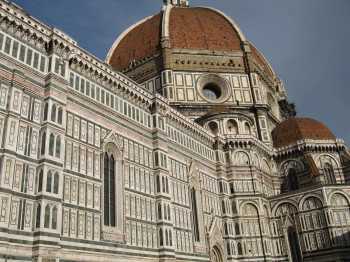 Photo PKGThe cathedral complex includes the Baptistry and Giotto's Campanile. The three buildings are part of the UNESCO World Heritage Site covering the Historic Centre of Florence and are a major attraction to tourists visiting the region. The basilica is one of Italy's largest churches, and until the modern era, the dome was one of the largest in the world, being surpassed in width only by that of the Pantheon in Rome. It remains the largest brick dome ever constructed.
Florence Baptistry
The octagonal Baptistry stands in the Piazza del Duomo, across from the Duomo cathedral and the Giotto bell tower (Campanile di Giotto). It is one of the oldest buildings in the city, built between 1059 and 1128. The architecture is in Florentine Romanesque style.
The Baptistry is renowned for its three sets of artistically important bronze doors with relief sculptures by Lorenzo Ghiberti.[1] These doors were dubbed by Michelangelo "the Gates of Paradise" because of their beauty, and they were said to have begun the Renaissance.
Piazza della Signoria
is an L-shaped square in front of the Palazzo Vecchio in Florence, Italy. It was named after the Palazzo della Signoria, also called Palazzo Vecchio.
It is the focal point of the origin and of the history of the Florentine Republic and still maintains its reputation as the political hub of the city. It is the meeting place of Florentines as well as the numerous tourists. 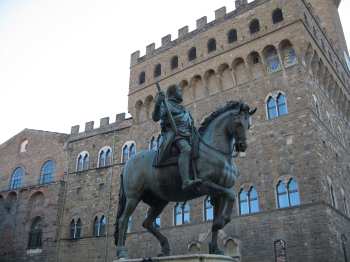 Photo PKG
The impressive 14th century Palazzo Vecchio is still preeminent with its crenellated tower. The square is also shared with the Loggia della Signoria, the Uffizi Gallery, the Palace of the Tribunale della Mercanzia (1359) (now the Bureau of Agriculture), and the Uguccioni Palace (16th Century, with a facade probably by Raphael). Located in front of the Palazzo Vecchio is the Palace of the Assicurazioni Generali (1871, built in Renaissance style).
Santa Maria Novella
Santa Maria Novella is a church in Florence, Italy, situated just across the main railway station which shares its name. Chronologically, it is the first great basilica in Florence, and is the city's principal Dominican church.
The Basilica di San Lorenzo (Basilica of St Lawrence) 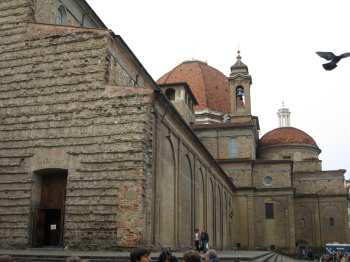 Photo PKG The Basilica of St Lawrence is one of the largest churches of Florence, Italy, situated at the centre of the city’s main market district, and the burial place of all the principal members of the Medici family from Cosimo il Vecchio to Cosimo III. It is one of several churches that claim to be the oldest in Florence
The Uffizi Gallery
The Uffizi Gallery is one of the most famous museums of paintings and sculpture in the world. Its collection of Primitive and Renaissance paintings comprises several universally acclaimed masterpieces of all time, including works by Giotto, Simone Martini, Piero della Francesca, Fra Angelico, Filippo Lippi, Botticelli, Mantegna, Correggio, Leonardo da Vinci, Raphael, Michelangelo and Caravaggio. German, Dutch and Flemish masters are also well represented with important works by Dürer, Rembrandt and Rubens.
The Uffizi Gallery occupies the top floor of the large building erected by Giorgio Vasari between 1560 and 1580 to house the administrative offices of the Tuscan State. The Gallery was created by Grand-duke Francesco I and subsequently enriched by various members of the Medici family, who were great collectors of
paintings, sculpture and works of art. The collection was rearranged and enlarged by the Lorraine Grand-dukes, who succeeded the Medici, and finally by the Italian State.
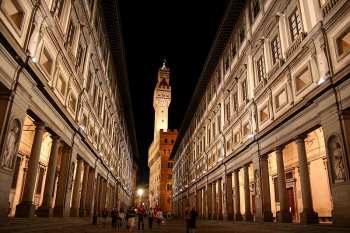 Photo Chris Wee
The Uffizi buildings also house other important collections: the Contini Bonacossi Collection and the Collection of Prints and Drawings (Gabinetto Disegni e Stampe degli Uffizi).
The Vasari Corridor, the raised passageway connecting the Uffizi with the Pitti Palace, was built by Vasari in 1565. It is hung with an important collection of 17th-century paintings and the famous collection of artists’ Self-portraits.
The Accademia Gallery
The Gallery of the Accademia di Belle Arti has housed the original David by Michelangelo since 1873. The sculpture was allegedly brought to the Accademia for reasons of conservation, although other factors were involved in its move from its previous outdoor location on Piazza della Signoria. The original intention was to create a 'Michelangelo museum', with original sculptures and drawings, to celebrate the fourth centenary of the artist's birth. Today the gallery's small collection of Michelangelo's work includes his four unfinished Prisoners, intended for the tomb of Pope Julius II, and a statue of Saint Matthew, also unfinished.
 Photo Rico Heil
Among the notable renaissance works on display are an outstanding collection of 15th and 16th century Florentine paintings by Paolo Uccello, Domenico Ghirlandaio, Sandro Botticelli and Andrea del Sarto and, from the High Renaissance, Giambologna's original plaster for the Rape of the Sabine Women.
The Basilica di Santa Croce (Basilica of the Holy Cross)
The Basilica of the Holy Cross is the principal Franciscan church in Florence, Italy, and a minor basilica of the Roman Catholic Church. It is situated on the Piazza di Santa Croce, about 800 metres south east of the Duomo. The site, when first chosen, was in marshland outside the city walls. It is the burial place of some of the most illustrious Italians, such as Michelangelo, Galileo, Machiavelli, Foscolo, Gentile, Rossini, and Marconi, thus it is known also as the Pantheon of the Italian Glories
Basilica of Santa Maria del Santo Spirito (St. Mary of the Holy Spirit)
The Basilica St. Mary of the Holy Spirit is one of the main churches in Florence, Italy. Usually referred to simply as Santo Spirito, it is located in the Oltrarno quarter, facing the square with the same name. The building on the interior is one of the pre-eminent examples of Renaissance architecture.
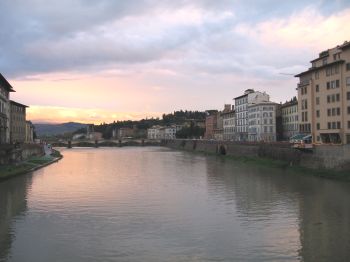 Photo PKG
| |
|
Festivals & Events
Vinum Bonum
This is a very special period in Valley Veneggia just south of Bolzano and just north of the upper tip of Lake Garda. For the entire month of August there are musical concerts held in a variety of the 27 wine-gowing 'cantinas' in the valley selected by a governing board for the high quality of the wines they produce. The tastings all begin at 4:30 in the afternoon and conclude at 7:00 PM and are only held on Tuesdays, Thursdays and Fridays.
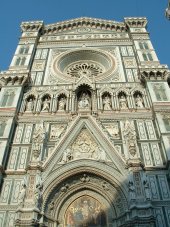 St. Maria del Fiore, Florence
Photo: BPG
International Piano Festival - Amalfi
July and August
The Chiostro del Paradiso is the setting for concerts by Italian and foreign pianists who alternate playing every Friday.
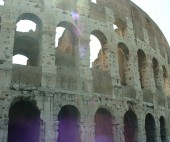 The Colosseum, Rome
Photo: BPG
MUSICAL WEEKS
Siena
August
Accademia Musicale Chigiana
Via di Città 89 - 53100 Siena
Tel. 39 0577 46152
Fax 39 0577 288124
Spoleto
June - July
Associazione Festival dei Due Mondi
Piazza Duomo 8 - 06049 Spoleto
Tel. 39 0743 220320 or 45028 or 40619
Fax 39 0743 220321
e-mail: spoletofestival@krenet.it
Torre del Lago Festival Pucciniano
August
Torre del Lago Puccini
Piazzale Belvedere 4 - 55048 Viareggio (Lucca)
Tel. 39 0584 350562
Fax 39 0584 350277 or 350562
Umbria Umbria Jazz
July
"Associazione Umbria Jazz"
P.O. Box 228 - 06100 Perugia
Tel. 39 075 62432
Fax 39 075 5730053
Viterbo Baroque Music Festival
August
Palazzo Santoro - Piazza Verdi 4/A 01100 Viterbo
Tel.39 0761 326666
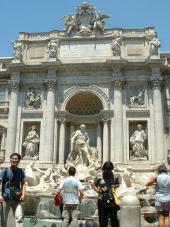 The Trevi Fountain, Rome
Photo: BPG
Ivrea Carnival
Early January
(lasts for 5 days)
In 2001 the carnival celebrated its 194th edition, but the area had started celebrating the events as early as the 1600s. The fight for liberty, when the men of Ivrea "expelled" the Marquis of Monferrato, is recreated with the Battles of the Oranges, which substitute stones. To make it fun there are several orange throwing "teams", all sporting colorful uniforms. The Carnival also has a lot of parties, food events and music.
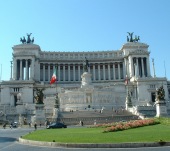 Vittorio Emanuele Monument, Rome
Photo: BPG
San Gennaro - Naples
September
San Gennaro, patron saint and protector of Napoli, stands for many as a symbol of the city itself, and his festival is one of the most passionately celebrated in all of Italy.
The festival ideally culminates in the miracle of the liquefaction of the blood of San Gennaro, which takes place every year more or less on the date of the festival. Many accept the divine nature of the event, and it is incontestable that the blood liquefies, but experts obviously differ on why or how this happens.
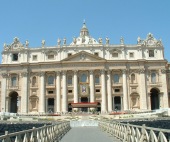 St. Peter's Basilica, Rome
Photo: BPG
Easter Sunday Florence
The annual 'holy fire' during Holy Week, is started with historical shards of the Holy Sepulchre, and is lit in the Church of SS Apostoli and transported to the Duomo, where the archbishop of the city lights the sacred 'Colombina' rocket with it during the Easter Mass. The rocket travels out of the Duomo along a wire, sets fire to the huge array of fireworks attached to the ICARRO and returns back into the church the way it came.
The celebration of the ceremony still bears a strong resemblance to the way in which it has been celebrated for centuries. On the morning of the day the Carro, pulled by two white oxen, leaves from Via del Prato for the Piazza del Duomo, accompanied by costumed revellers and various city officials and clerical representatives.
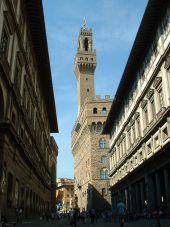 Palazzo Vecchio, Florence
Photo: BPG
The Palio delle Contrade,
Siena
July
A banner, decorated with an image of the Virgin Mary, is presented to the winner of a horse race around the Siena's Piazza del Campo. Competitors come from each one of the 17 districts of the city.
The race consists of bareback riders making three circuits of the main square and is over in 90 seconds. But it is preceded by 5 hours of flag throwing acrobatics around the main square.
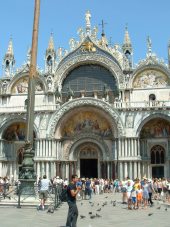 St. Marco Basilica, Venice
Photo: BPG
Viareggio
February - March
Every year The Viareggio Carnival is the most spectacular in Italy, and is known world-wide. The people of Viareggio begin preparing the huge papier-maché puppets in hangar-like buildings by the sea. The figures satirise public and political figures; making them and setting them atop the floats requires considerable technical skill as well as creativity and imagination.
The voluminous floats parade around Viareggio competing for the finest float award from 2.30pm until 9pm on the following dates: 11, 18, 25, 27 Feb and 4 March, each one carrying about 200 people in costume, as well as the huge moving, Trojan horse-like puppets, which hold people inside to manoeuvre the weights, counter-weights and levers that prevent them from toppling over.
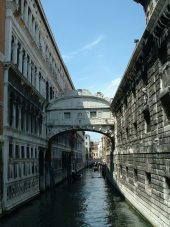 The Bridge of Sighs, Venice
Photo: BPG
|
|
|